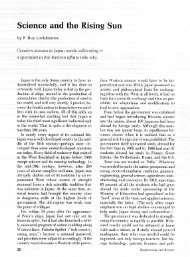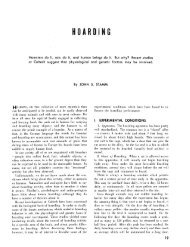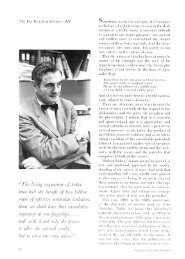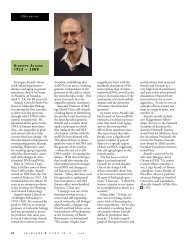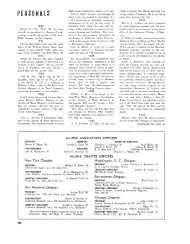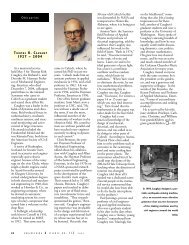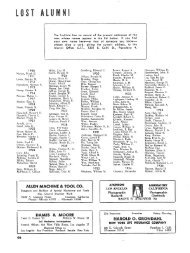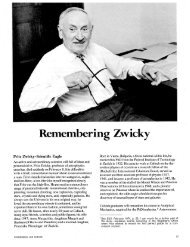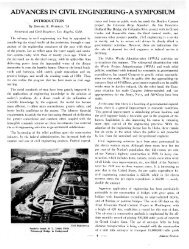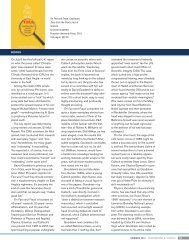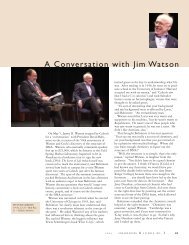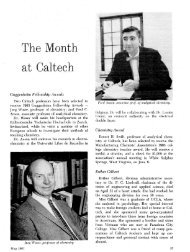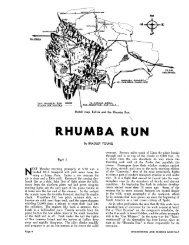indicates - Engineering & Science - California Institute of Technology
indicates - Engineering & Science - California Institute of Technology
indicates - Engineering & Science - California Institute of Technology
Create successful ePaper yourself
Turn your PDF publications into a flip-book with our unique Google optimized e-Paper software.
The mitochondria are the<br />
“powerhouses” <strong>of</strong> the cell and<br />
have their own DNA, leading<br />
researchers to believe they<br />
were once independent organ-<br />
isms that were long ago<br />
assimilated. Mitochondrial<br />
DNA passes only from<br />
mother to <strong>of</strong>fspring, and<br />
every human cell contains<br />
hundreds, or, more <strong>of</strong>ten,<br />
thousands <strong>of</strong> mtDNA<br />
molecules. It’s known that<br />
mtDNA has a high mutation<br />
rate, and that such mutations<br />
can be harmful, beneficial, or<br />
neutral. In 1999, Attardi<br />
and colleagues found what<br />
Attardi described as a “clear<br />
trend” in the number <strong>of</strong><br />
mtDNA mutations in individuals<br />
over the age <strong>of</strong> 65—<br />
in fact, in the skin cells the<br />
researchers examined, they<br />
found that up to 50 percent<br />
P A G E D B Y A G A M M A - R AY B U R S T<br />
Scientists “arriving quickly<br />
on the scene” <strong>of</strong> an October 4<br />
gamma-ray burst have seen,<br />
for the first time, that fresh<br />
energy continued to stoke its<br />
afterglow for more than half<br />
an hour after the initial<br />
explosion. The blast was first<br />
detected by NASA’s High-<br />
Energy Transient Explorer<br />
(HETE) satellite, and followup<br />
observations were quickly<br />
undertaken by fast-thinking<br />
researchers around the globe,<br />
who report in the March 20<br />
issue <strong>of</strong> Nature. The findings<br />
support the “collapsar” model<br />
<strong>of</strong> gamma-ray bursts, in<br />
which they are emitted after<br />
the core <strong>of</strong> a star 15 times<br />
more massive than the sun<br />
collapses into a black hole.<br />
“If a gamma-ray burst is the<br />
birth cry <strong>of</strong> a black hole, then<br />
the HETE satellite has just<br />
allowed us into the delivery<br />
room,” said Derek Fox, a<br />
<strong>of</strong> the mtDNA molecules<br />
had been mutated. (See E&S,<br />
1999, No. 4.) In another<br />
study two years ago, Attardi<br />
and colleagues found four<br />
centenarians who shared a<br />
genetic change in the socalled<br />
main control region <strong>of</strong><br />
mtDNA. Because this region<br />
controls DNA replication,<br />
that observation raised the<br />
possibility that some mutations<br />
may extend life.<br />
Now, by analyzing mtDNA<br />
isolated from a group <strong>of</strong><br />
Italian centenarians, the<br />
researchers have found a<br />
common mutation in the<br />
same main control region.<br />
Looking at mtDNA in white<br />
blood cells <strong>of</strong> a group <strong>of</strong> 52<br />
Italians between the ages <strong>of</strong><br />
99 and 106, they found that<br />
17 percent had a specific<br />
mutation called the C150T<br />
Caltech postdoc and lead<br />
author <strong>of</strong> the Nature paper.<br />
Fox discovered the afterglow<br />
using the Oschin 48-inch<br />
telescope located at Caltech’s<br />
Palomar Observatory.<br />
Gamma-ray bursts shine<br />
hundreds <strong>of</strong> times brighter<br />
than a supernova, or as bright<br />
as a million trillion suns.<br />
The mysterious bursts are<br />
common, yet random and<br />
fleeting. The gamma-ray<br />
portion <strong>of</strong> a burst typically<br />
lasts from a few milliseconds<br />
to a couple <strong>of</strong> minutes. An<br />
afterglow, caused by shock<br />
waves from the explosion<br />
sweeping up matter and<br />
compressing it until the heat<br />
makes it glow, can linger for<br />
much longer, releasing energy<br />
in X rays, visible light, and<br />
radio waves.<br />
This gamma-ray burst,<br />
called GRB021004, appeared<br />
on October 4, 2002, at 8:06<br />
4 E N G I N E E R I N G & S C I E N C E N O . 1 2 0 0 3<br />
transition. That frequency<br />
compares to only 3.4 percent<br />
<strong>of</strong> 117 people under the age<br />
<strong>of</strong> 99. To probe whether the<br />
mutation is inherited, the<br />
team studied skin cells<br />
collected from the same<br />
individuals between 9 and<br />
19 years apart. In some, both<br />
samples showed that the<br />
mutation already existed,<br />
while in others, it either<br />
appeared or became more<br />
abundant during the intervening<br />
years. These results<br />
suggest that some people<br />
inherit the mutation from<br />
their mother, while others<br />
acquire it during their<br />
lifetime.<br />
“We found the mutation<br />
shifts the site at which<br />
mtDNA starts to replicate,<br />
and perhaps that may accelerate<br />
its replication, possibly<br />
a.m. EDT. Seconds after<br />
HETE detected the burst, its<br />
coordinates were downlinked<br />
to computers at NASA’s<br />
Goddard Space Flight Center<br />
that generated an e-mail to a<br />
list <strong>of</strong> observatories around<br />
the world, including Palomar.<br />
Fox pinpointed the afterglow<br />
from images captured by the<br />
Oschin Telescope within minutes<br />
<strong>of</strong> the burst, and notified<br />
the astronomical community<br />
by e-mail. Then the race was<br />
on, as scientists in <strong>California</strong>,<br />
across the Pacific, Australia,<br />
Asia, and Europe employed<br />
more than 50 telescopes to<br />
zoom in on the afterglow<br />
before the approaching<br />
sunrise.<br />
At about the same time,<br />
the afterglow was detected by<br />
the Automated Response Telescope<br />
(ART), a 20-centimeter<br />
instrument located in a Tokyo<br />
suburb and operated by the<br />
allowing the lucky individual<br />
to replace damaged molecules<br />
faster,” Attardi says, adding<br />
that the study is the first to<br />
show a robust difference in<br />
an identified genetic marker<br />
between centenarians and<br />
younger folks. Their next<br />
goal, he says, is to find the<br />
exact physiological effect <strong>of</strong><br />
this particular mutation.<br />
The Italian contributors to<br />
the paper were Massimiliano<br />
Bonafe, Fabiola Olivieri, Giuseppe<br />
Passarino, Giovanna De<br />
Benedictis, and Claudio Franceschi.<br />
It appeared in the<br />
February 4 issue <strong>of</strong> the Proceedings<br />
<strong>of</strong> the National Academy <strong>of</strong><br />
<strong>Science</strong>s, and online at http://<br />
www.pnas.org. ■—MW<br />
Japanese research institute<br />
RIKEN. ART started<br />
observing the region a mere<br />
193 seconds after the burst,<br />
but it took a few days for<br />
these essential observations<br />
to be properly analyzed and<br />
distributed.<br />
The combined observations<br />
revealed “flickers” that hinted<br />
that energy was still being<br />
injected into the afterglow<br />
well after the burst occurred.<br />
According to Shrinivas<br />
Kulkarni, the MacArthur<br />
Pr<strong>of</strong>essor <strong>of</strong> Astronomy and<br />
Planetary <strong>Science</strong> and a coauthor<br />
<strong>of</strong> the Nature paper,<br />
this power must have been<br />
provided by whatever object<br />
produced the gamma-ray<br />
burst itself. “This ongoing<br />
energy shows that the explosion<br />
is not a simple, one-time<br />
event, but that the central<br />
source lives for a longer time.<br />
This is bringing us closer to



